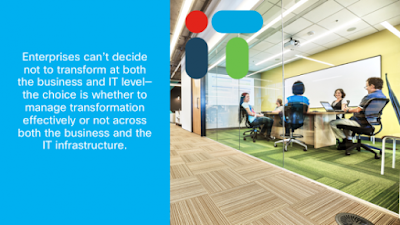If you are a part of or even peripherally connected to an IT organization or managed services provider, you probably hear the word “transformation” daily, perhaps even more frequently. Like other well-worn terms such as “Digitization,” “DevOps,” or “Agile,” transformation can mean a lot of different things depending on the specific organization, the team, or the individual person saying it or hearing it. It’s a word that’s used so often that it can sometimes confuse rather than clarify discussions. While not quite there yet, transformation threatens to enter the pantheon of over-used and “buzzy” corporate-speak that serves only as filler content to obfuscate specificity.
At its core, though, transformation is not an empty concept — far from it! It is a very expansive concept that encompasses many activities that an Enterprise carries out to undergo radical change at the core business and operational level. We just have to be very specific about what we really mean by the term “transformation.” What are the activities focused on? What are the tactics to achieve the transformational goal? And what are the tools and/or services necessary to bring about successful transformation? Notice that I don’t hint at multiple goals for transformation. That’s because Enterprises have only one goal with transformation, always and every time: adaptive and radical change to business processes and IT infrastructures to survive and thrive.
You can debate without end the chicken-and-egg question of whether Enterprise transformation begins with business transformation or IT transformation. In other words, does radical change with business operations precede the need for supporting IT transformation, or does the relentless evolution and implementation of new technologies, platforms, and tools drive business transformation? Which one begets the other, or does a fixed linear order to this progression even exist?
Is It a Question for Philosophers?
You can debate without end the chicken-and-egg question of whether Enterprise transformation begins with business transformation or IT transformation. In other words, does radical change with business operations precede the need for supporting IT transformation, or does the relentless evolution and implementation of new technologies, platforms, and tools drive business transformation? Which one begets the other, or does a fixed linear order to this progression even exist?
It’s a bit of a philosophical question that has been debated in many excellent pieces on Enterprise technology and operations. Trying to crack the riddle about which one should come first ignores the fact that they are always symbiotic in their dependence on each other. Radical and aggressive change at the core business level — how an Enterprise innovates, competes, and carries out all the relevant activities to do so — cannot in this day and age take root without at least transforming some of the IT services vitally necessary at the operational level. Most of the time, though, it’s not a fringe adoption of new IT devices and tools but rather a complete adoption of disruptive new technology paradigms resulting in drastic change to IT infrastructures and services available to employees. By the same token, creating this type of drastic change at the technology level always causes core business operations to shift their course and transform operational processes and procedures; the business must transform when new technologies are implemented. The point here is that whether it starts with the business or IT, to transform one requires parallel transformation of the other.
The Demands of Transformation
What’s really relevant here is that Enterprise transformation is very demanding across the organization. It touches every corner of the Enterprise and requires unique skills and expertise to analyze how best to carry out transformation—business or IT — and then execute on that plan. Most of the time, Enterprises attack the transformational problem by putting internal resources on it, assigning task forces or “tiger” teams to implement transformational activities locally under the coordination of a programmatic function. This team is charged with managing overarching change across the Enterprise.
This strategy makes sense. Assigning the best and brightest human-resource assets to affect such radical change within the business and IT is natural — you want the most skilled and knowledgeable people eliminating problems, reducing risk, and ensuring success of such critical programs. Most of the time, these are the Enterprise’s star players who have shown time and again that they can make things happen for the company. Who could argue with that?
A counter-intuitive assertion is that this approach could at best hamstring the Enterprise and at worst doom the transformation to great pain, delay, and perhaps even failure. Why? Because the Enterprise has just taken its eye of the ball, allowing its internal operations to become defocused. By taking away star players and innovators across the Enterprise and tasking them with the all-encompassing activities demanded by business and IT transformation, the Enterprise has less of a focus — and fewer of the its movers and shakers — on the core business and strategic outcomes that keep it alive and competitive in the market and on the IT infrastructures that support that core business.
Several realizations should be apparent at this time:
- Enterprises don’t really have a choice to transform or not. Transformation is thrust upon it either from business or IT catalysts and sweeps quickly throughout the Enterprise. Adapt or die.
- Managing transformation effectively or not is the only choice presented to the organization. The way in which transformation occurs is entirely up to the Enterprise.
- Assigning star employees to the never-ending task of transformation is risky business — these are the skilled workers who bolster the core business with their contributions. Taking them away from the core business leaves a huge gap ion the front line.
- Lastly, most Enterprises, no matter how strong the internal talent base, are not fully equipped to handle every aspect of business and IT transformation.
So How Has Enterprise Transformation Transformed Managed Services?
Managed Services providers of IT services and solutions enter the transformational picture at this point. For the smart organization that has consciously decided not to defocus internal IT staff but rather augment their IT operations with third-party IT services, this means that they can leverage the provider’s far more comprehensive skillsets and capabilities. Effective managed services providers can assure more effective transformation by managing legacy equipment, refreshing the environment where necessary, upgrading or replacing technology infrastructures, and providing ongoing operations to troubleshoot problems and optimize the IT environment.
But as we’ve been discussing, transformation does not happen in a vacuum or in an isolated part of the organization. Transformation is intended to change radically for the better all parts of the Enterprise, with the key processes and operations of the business being transformed along with the IT infrastructure. What happens in one area greatly affects the other. Managed Service providers have had to grapple with the painful conclusion that last-generation offers did not support true Enterprise transformation as we’ve been defining it here. The focus on device monitoring, limited solutions support, line-item deliverables through individual incident-resolution capabilities, and just keeping the infrastructure stable while bits and pieces were replaced no longer provides value to the transformational Enterprise. Because of the realities of Enterprise transformation, Managed Services providers have had to transform themselves and their offers, becoming far more holistic, working with their peer service groups to provide truly transformative outcomes and comprehensive solutions that positively affect core business and IT operations.
What Transformational Managed Services Look Like
Here are some of the ways managed services providers have had to change in order to support Enterprise transformation:
- Managed services can’t just be focused on the Day 2 operations of devices and solutions after deployment into production environments. Managed services providers have to be focused on outcomes and holistic solutions that support transformation across the business and IT operations: this means the provider having seamless engagements with all teams within it working, communicating, and collaborating together to provide those outcomes from Day 0 to Day 2.
- Managed services can’t just be a commoditized proposition to provide narrow monitoring and other Day 2 operations services at the cheapest price point. Providers who want to underpin their customers’ transformations can’t just offer up the “your mess for less” proposition to help the Enterprise outsource IT activities. Nothing transformational comes out of this approach. Enterprises that are serious about radical business and IT transformations know that this is not a quest for the bargain price. Sure, they don’t want to pay more than they have to, but they want to have mess removed and secure all the positive outcomes that transformation can offer.
- Managed services providers can’t just be focused solely on the operating expenditure (OpEx) reductions that were part of the last-generation value proposition. Yes, market studies have shown that OpEx reductions are real and can even be significant when the right provider is involved. On top of that, efficiency gains at the core business level spurred by the right managed services can lead to greater innovation, streamlined operations, and ultimately more productive output, which leads to greater revenue. But again, this is not necessarily true Enterprise transformation, the goal of which is to significantly change the way a company does business by providing employees with new IT services that shift the way they communicate, collaborate, and innovate.
- Managed services providers can’t seek projects or engagements with customers; rather, they need to manage complete transformational journeys for their customers, partnering with them to provide complete visibility into and control over the journey while bringing that transformation to fruition.Only the most advanced and skilled managed services providers are themselves transformed enough to provide these and other transformational benefits for Enterprise customers.









0 comments:
Post a Comment